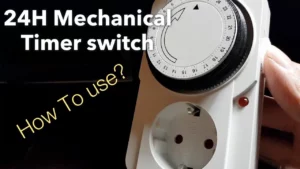So, you’ve decided to buy a time switch, but don’t know where to start? Don’t worry. We’ve got you covered.
There are many types of time switches and they all have their upsides and downsides. In the end, it all depends on your needs and preferences. So, let’s take a look at the most common types of time switches.
1. Three Major Time Switch Types
#1 Analog Time Switch
The analog time switch is also known as the manual or mechanical switch. The design is based on a spring that tracks the time.
Analog time switches are incredibly simple to use. All you have to do is to wind the dial to a specific time. It’s actually similar to setting your watch or using a time knob on your oven.
Also, because of its simplicity, it’s quite durable. Let’s face it — it’s much harder to break any mechanical device than a digital one.
Another good thing about this type of a time switch is that it’s relatively cheap. So, if you’re not ready to invest a lot of money in a switch, this might be the perfect option for you.
As for the time settings, they vary from model to model. Some analog time switches allow you to set as many on or off periods within 24 hours as you like. Others are limited to a 60 minute period.
Bear in mind that there are two types of analog time switches. Plug-in switches look like electrical sockets that feature time control. All you need to do is to plug it in and set the time. In-wall switches are a bit more complicated, as you have to install them into your walls.
Advantages of Mechanical Time Switches:
- Simple to install and use
- Reliable
- Durable
- Inexpensive
#2 Digital Time Switch
Digital time switches are programmable. Therefore, they offer more options than the analog ones and can handle lots of different situations.
Digital switches offer multiple on/off cycles in a period of 24 hours. Also, you can set the on-off timing for more than just one. For example, if you’re going on a vacation, you can set a 7-day schedule. Moreover, some models allow you to set different settings for different days of the week.
Another great thing about digital time switches is that they can be password-protected. That way, your kids, or even a stranger, won’t be able to change your settings.
There are also digital time switch models that include various sensors. They can recognize sunlight or movements in their vicinity, and turn the lights on or off accordingly.
Finally, newer models usually use smart technology. This means that you can connect them to your phone or tablet, and then use the device as a remote control. Moreover, some models even support services such as Alexa and Google Home, which allow for voice control.
Just like the mechanical ones, digital time switches come in two forms: plug-in and in-wall.
Advantages of Digital Time Switches
- Offer numerous options
- They can include sensors
- Slimmer, visually appealing design
- Versatile
#3 Astronomic Time Switch
Astronomic time switches are actually a type of digital switch. However, they use a different system compared to regular digital ones.
Astronomic switches work based on the time of the day. They have built-in technology that calculates the exact timing of sunrise and sunset. So, they turn the lights on or off based on those calculations.
Moreover, most models come with remote control. However, they don’t offer many other options.
Other Types of Time Switches
These three types of time switches are the most common. However, there are plenty of other types that you might find useful. Some of these are irrigation timers, water heater time switches, and staircase time switches.
2. How to Choose the Best Time Switch
With so many different types, it all comes down to your own needs. Here are some things you should keep in mind when choosing a time switch.
Wattage rating: Every time the switch has a wattage rating. When picking a time switch, be careful to choose the one that can handle all your devices and lights. The best way to ensure this is, to sum up the wattage of your appliances and light bulbs and search for a switch accordingly.
Device support: Before buying a time switch, check if it supports your devices. For example, some switches will work on lights, but not on motors like bathroom fans. Also, if you plan to use the switch on fluorescent and low-wattage lights, bear in mind that not all models support them.
Light configuration: Most times switches support single-pole switch setups. So, if you’re looking for a switch that will control the lights in its vicinity, you don’t need to worry about this. However, many models don’t support three-way and four-way switches. Thus, if you want your switch to control lights on opposing sides of your hallway, you should look for a more advanced model.
3. Conclusion
With so many types and models available, you have a great offer to choose from. Whatever your needs may be, we’re sure you’ll find a model that fits you perfectly.









